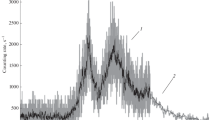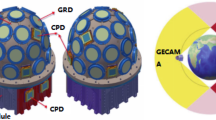Abstract
Introduction
The main physical objective of the GECAM satellite is to detect gamma-ray bursts, which is related to gravitational waves of double compact object mergers. The GECAM satellite also detects and investigates various bursts of high-energy celestial bodies.
Purposes and methods
In this study, we designed, developed and calibrated the payload and launched it into orbit with GECAM satellite. The payload consists of the gamma ray detector (GRD, for detecting 4 keV–4 MeV X/γ ray), the charged particle detector (CPD, for detecting 150 keV–5 MeV charged particle), and the electronic box (EBOX). The all-sky field coverage is achieved via two 229-degree large-area satellites positioned 180 degrees apart and are on opposite sides of the geo-center. Each satellite is equipped with 25 GRDs and 8 CPDs; thus, the satellite can identify charged particle bursts in space. Gamma-ray detectors adopt lanthanum bromide crystal technology combined with silicon photomultipliers. This is the first time that this technology was used massively in space detectors.
Conclusions
The GECAM satellite can quickly determine the direction of gamma-ray bursts (positioning) via indexing and fitting method, while the transmit variability, energy spectrum and direction of the gamma-ray bursts guide subsequent observations through the Beidou-3 RDSS in quasi-real time. It will play an important role in the study of high energy celestial bursts.














Similar content being viewed by others
References
S.L. Shapiro, S.A. Teukolsky, Black holes, white dwarfs, and neutron stars: the physics of compact objects[J]. Phys. Today 36(10), 89–90 (1983)
B. Abbott, R. Abbott, T.D. Abbott et al., Observation of gravitational waves from a binary black hole merger[J]. Phys. Rev. Lett. 116(6), 291–311 (2016)
B.P. Abbott et al., (LIGO Scientific Collaboration and Virgo Collaboration), GW170817: observation of gravitational waves from a binary neutron star inspiral. PRL 119, 161101 (2017)
F. Gbm, A.C. Team, A. Team et al., Multi-messenger observations of a binary neutron star merger[J]. Astrophys. J. 848(2), 1–59 (2017)
B. Abbott, R. Abbott, T.D. Abbott et al., Gravitational waves and gamma-rays from a binary neutron star merger: GW170817 and GRB 170817A[J]. Astrophys. J. 848(2), 1–27 (2017)
P. D’Avanzo1, S. Campana1, O.S. Salafia, et al., The evolution of the X–ray afterglow emission of GW 170817/GRB 170817A in XMM-Newton observations. Astron. Astrophys. http://arxiv.org/abs/1801.06164v2 (2018)
A. Murguiaberthier, E. Ramirezruiz, C.D. Kilpatrick et al., A neutron star binary merger model for GW170817/GRB 170817A/SSS17a[J]. Astrophys. J. 848(2), L34 (2017)
J.J. Ruan, M. Nynka, D. Haggard et al., Brightening x-ray emission from GW170817/GRB 170817A: further evidence for an outflow[J]. Astrophys. J. 853(1), L4 (2018)
T. Li, S. Xiong, S. Zhang et al., Insight -HXMT observations of the first binary neutron star merger GW170817[J]. Sci. China Phys. Mech. Astron. 61(3), 1–8 (2018)
B. P. Abbott, et al., (LIGO Scientific Collaboration and Virgo Collaboration), GW170814: a three-detector observation of gravitational waves from a binary black hole coalescence. PRL 119, 141101 (2017)
LIGO Scientific Collaboration and Virgo Collaboration, Fermi Gamma-ray Burst Monitor, and INTEGRAL, Gravitational Waves and Gamma-Rays from a Binary Neutron Star Merger: GW170817 and GRB 170817A. Astrophys. J. Lett. 848, L13 (2017)
C.S. Kochanek, T. Piran, Gravitational waves and gamma -ray bursts. Astrophys. J. (1993). https://doi.org/10.1086/187083
H.A. Krimm et al., The swift/bat hard x-ray transient monitor. Astrophys. J. Suppl. Ser. 209, 14 (2013)
C. Meegan et al., The fermi gamma-ray burst monitor. Astrophys. J. 702(791–804), 1 (2009)
K. Yamaoka, A. Yoshida, Y. Nonaka, et al., The CALET Gamma-ray Burst Monitor (CGBM). in Proceedings of the 32nd International Cosmic Ray Conference, ICRC 2011 (Vol. 9, pp. 111–114). Institute of High Energy Physics. (2011) https://doi.org/10.7529/ICRC2011/V09/0839
C.-M. Zhang, Y.-Q. Ma, H.-Y. Wang et al., On border the spaceship “Shen Zhou 2” X ray detector and its calibration and performance at orbit. Nuclear Electron. Detect. Technol. 1, 1–7 (2005)
T. Ma, J. Chang, N. Zhang, W. Jian et al., Gamma-ray spectrometer onboard Chang’E-2. Nuclear Instrum. Methods Phys. Res. Sect. A Accel. Spectr. Detect. Assoc. Equip. 726, 113–115 (2013). https://doi.org/10.1016/j.nima.2013.05.162
S.-N. Zhang et al., Overview to the hard X-ray modulation telescope (insight-HXMT) satellite. Sci. China Phys. Mech. Astron. (2020). https://doi.org/10.1007/s11433-019-1432-6
J. Sun, B. Wu, T. Bao, et al., Performance study of the gamma-ray bursts polarimeter POLAR[J]. in Proceedings of SPIE (2016)
J. Wen, X. Long, X. Zheng, Y. An, H. Feng, M. Zeng et al., GRID: a student project to monitor the transient gamma-ray sky in the multi-messenger astronomy era. Exp. Astron. 48, 77 (2019)
X. Li et al., The GECAM and its payload. Sci. Sin. Phys. Mech. Astron. 50(12), 129508 (2020). https://doi.org/10.1360/SSPMA-2019-0417
Band et al., BATSE observations of gamma-ray burst spectra. I. Spectral diversity. ApJ 413, 281 (1993)
D. Zhang, X. Li, S. Xiong et al., Energy response of GECAM gamma-ray detector based on LaBr 3: Ce and SiPM array. NIMA 921, 8–13 (2019)
D. Guo, W. Peng, Y. Zhu, G. Li, J. Liao, S. Xiong, R. Qiao, X. Li, Z. An, Y. Xu, S. Yang, D. Zhang, X. Sun, Energy response and in-flight background simulationfor GECAM. Sci. Sin. Phys. Mech. Astron. 50(12), 129509 (2020). https://doi.org/10.1360/SSPMA-2020-0015
R.-Q. Song, Z.-H. An, J.-J. Wu, W.-C. Lai, S.-M. Guo, P.-Y. Zhou, X.-Q. Li, Research on the performance of GECAM satellite LaBr 3(Ce)detector in low energy region. Nuclear Electron. Detect. Technol. 3, 467–473 (2020)
V. Connaughton et al., Localization of gamma-ray bursts using the fermi gamma-ray burst monitor. ApJS 216, 32 (2015). https://doi.org/10.1088/0067-0049/216/2/32
X. Zhou, X. Li et al., Introduction to a calibration facility for hard X-ray detectors. Exp. Astron. 38(3), 433–441 (2014)
Z. An, et al., The design and performance of GRD onboard the GECAM satellite, RDTM, GECAM special issue, 2021 (the detail need to be updated)
Z. Zhang, L. Chen, X. Li et al., Observed propagation route of VLF transmitter signals in the magnetosphere. J. Geophys. Res. Space Phys. 123(7), 5528–5537 (2018). https://doi.org/10.1029/2018JA025637
Z.X. Zhang, X.Q. Li et al., North west cape-induced electron precipitation and theoretical simulation. Chin. Phys. B 25(11), 119401 (2016)
X. Li et al., Study of the North West Cape electron belts observed by DEMETER satellite. J. Geophys. Res. Space Phys. 117, A04201 (2012)
Acknowledgements
The authors wish to thank Professor LIU Zhidong, Professor TIAN Zongjun, Researcher WU Jinjie, Professor SHEN Lida, associate Professor QIU Mingbo, senior engineer ZHANG Aimei, associate researcher LI Zhengwei, associate researcher ZHANG Yifei, commander and chief designer of the GECAM Satellite Project and colleagues for their assistance and help in filing and R&D of the project; we thank Beijing Glass Research Institute for producing and supplying sealed lanthanum bromide crystals for GRD detectors; we thank Shandong Aerospace Electronic Technology Research Institute for assistance in engineering, integrated testing and verification of detectors; we thank the National Institute of Metrology for assistance in GRD calibration; we thank the National Space Science Center, CAS for assistance in CPD calibration; and thank Northwest Rare Metal Materials Research Institute for assistance in supplying beryllium pieces. This project is supported by National Natural Science Foundation of China (12173038) and the strategic leading science and technology program (XDA 15360100, XDA 15360102) of the Chinese Academy of Sciences.
Author information
Authors and Affiliations
Corresponding author
Rights and permissions
About this article
Cite this article
Li, X.Q., Wen, X.Y., An, Z.H. et al. The technology for detection of gamma-ray burst with GECAM satellite. Radiat Detect Technol Methods 6, 12–25 (2022). https://doi.org/10.1007/s41605-021-00288-z
Received:
Revised:
Accepted:
Published:
Issue Date:
DOI: https://doi.org/10.1007/s41605-021-00288-z




